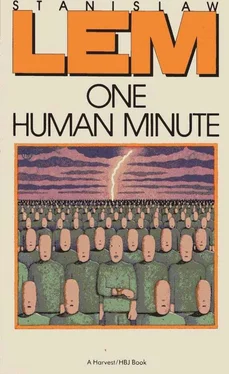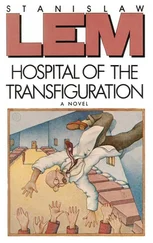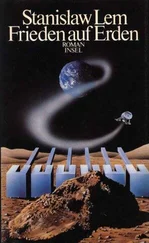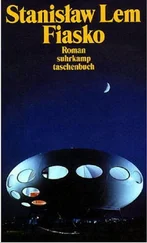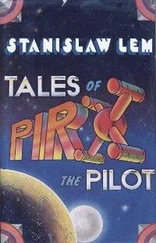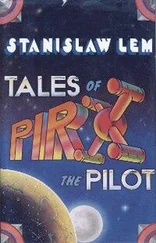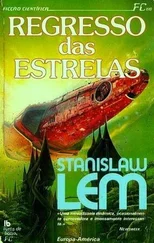Even in the twentieth century, the tactic of fighting in close ranks gave way to the spreading of troops, and in a mobile war the spreading was still greater. But the front lines still existed, separating friend from foe. Now such boundaries disappeared completely.
A microarmy could easily penetrate all systems of defense and go deep into enemy territory. It had no more trouble accomplishing this than did rain or snow. Meanwhile, high-powered nuclear weapons were proving more and more useless on the battlefield. Imagine, if you will, an attempt to combat a virus epidemic with thermonuclear bombs. It was possible, of course, to scorch a large territory down to a depth of fifty feet, turning it into a vitrified, lifeless desert. But what good was that if on that expanse, one hour later, a military rain began to fall and from it there crystallized detachments of shock troops? Hydrogen bombs were expensive. One didn’t hunt in warships for leeches or sardines.
The greatest problem in the unhuman stage of military history was that of distinguishing friend from foe. This task had been accomplished, in the twentieth century, by means of electronic systems working on a password principle. Challenged by radio, a plane or an unmanned missile either radioed the right answer or else was attacked as an enemy craft. This ancient method now proved useless. The new weapon-makers again borrowed from the biosphere — from plants, bacteria, and insects.
Recognition duplicated the methods of identification used among living species: their immunology — the struggle of antigen with antibody — tropisms, protective coloration, camouflage, and mimicry. The nonliving weapon might imitate (extremely well) floating dust specks or pollen, or gnats, or drops of water. But under that mask lay a corrosive or lethal agent.
It should be pointed out that although I am using metaphors from entomology in talking about attacks of artificial locusts or other insects, I do so as a twentieth-century person would describe, to the contemporaries of Vasco Da Cama or Christopher Columbus, a modern city with its automobile traffic. He would speak of carriages and wagons without horses; he would compare airplanes to birds made of metal. In this way he would evoke in the minds of his listeners images that had some connection with reality, albeit an imperfect one. A carriage rolling on large, thin wheels, with high little doors and a dropped step, with a box for the coachman and places at the back for the servants, is not a Fiat or a Mercedes. By the same token, the twenty-first-century synsect weapon is not a swarm of insects just like the ones in an entomologist’s atlas, only made of metal.
Some of the pseudo-insects could pierce the human body like bullets; others could form optical systems to throw sunlight over wide areas, altering the temperature of large air masses so as to produce heavy rainfall or fair weather, according to the needs of the campaign. There existed “meteorological insects” corresponding to nothing we know today. The endothermic synsects, for example, absorbed large quantities of energy for the sole purpose of causing a sudden drop in temperature over a given area, resulting in a thick fog or the phenomenon known as an inversion. Then there were synsects able to concentrate themselves into a single-use laser beamer; they replaced the artillery of the previous century — although one can hardly speak of replacement, since artillery as we understand it would have been of as much use on the battlefield as slings and catapults. New weapons dictated new conditions of combat and, therefore, new strategy and tactics, both totally unhuman.
For those who loved the uniform, the flag, the changing of the guard, standing at attention, drill, medals, and bayonet charges, the new era of war was an affront to their noble ideals, a mockery, a disgrace! The experts of the day called the new military science an “upside-down evolution,” because in nature what came first were the simple, microscopic systems, which then changed over the eons into larger and larger life forms. In the military evolution of the postnuclear period, the exact opposite took place: microminiaturization.
The microarmies developed in two stages. In the first stage, the unhumaned microweapons were still designed and built by people. In the second stage, microsoldiers were designed, combat-tested, and sent to be mass-produced by “construction battalions” of nonliving microdesigners.
A phenomenon known as “sociointegrative degeneration” displaced humans first from the military and later from the weapons industry. The individual soldier degenerated when he ceased to be an intelligent being with a large brain and grew increasingly small and therefore increasingly simple, or when he became disposable, a “single-use soldier.” (Some of the antimilitarists had maintained, long before, that modern warfare’s high mortality rate made “single-use soldiers” of all the combatants, with the exception of the top-ranking officers.) In the end, a microfighter had as much brain as an ant or a termite.
A greater role, then, was assumed by the pseudo-sociointegrative collective of microsoldiers. Each nonliving army was incomparably more complex than a beehive or an anthill. In internal structure and interrelationships it was more akin to an ecological unit in nature — that is, to those pyramids of plant and animal species that coexist in a specific region or habitat in evolutionary equilibrium, with their antagonisms and symbioses forming a complex network of interdependencies.
It is easy to see that in such an army there was nothing for noncommissioned officers to do. A corporal or a sergeant, even a general, could not lead a division of such an army. To grasp the whole picture, as complex as nature itself (although quite dead), the wisdom of a university senate would not have sufficed — even for a mere inspection, much less an actual campaign. Besides the impoverished nations of the Third World, therefore, those who suffered the most from the great military revolution of the twenty-first century were the officer cadres.
The twentieth century had already begun the process of destroying them, dispensing with swords, three-cornered hats, and gorgeous uniforms. The final blow, however, was dealt in the twenty-first century by the army’s pseudo-insect evolution — or, rather, involution. The cruel pressure to unhumanize the armies did away with the picturesque traditions of war games, the pageantry of parades (a marching locust, unlike a procession of tanks or rockets, is not a grand sight), the bayonet drills, the bugle calls, the flag raisings and lowerings, the roll calls, the whole rich fabric of barracks life. For a time, high-ranking command positions were kept for people, but not for very long.
The strategical-numerical superiority of the computer-produced echelons finally forced even the most competent of commanders, including field marshals, into retirement. A tapestry of ribbons and medals on the chest was no protection against being put out to pasture. In various countries, at that time, a resistance movement developed among career officers. In the desperation of unemployment, they even joined the terrorist underground. It was a malicious trick of history — no one deliberately planned it — that these insurrections were crushed by means of micro-spies and minipolice built on the model of a particular cockroach.
This roach, first described in 1981 by an eminent American neuroentomologist, has at the end of its abdomen fine hairs that are sensitive to even the slightest stirring in the air. Connected to a special dorsal nerve bundle, the hairs enable the roach to detect the approach of an enemy, even in complete darkness, and so to flee instantly. The counterparts to these hairs were the electronic picosensors of the minipolicemen who concealed themselves in cracks in old wallpaper at the rebel headquarters.
Читать дальше
